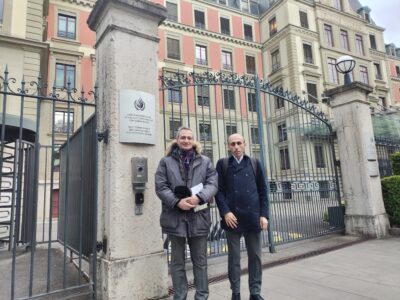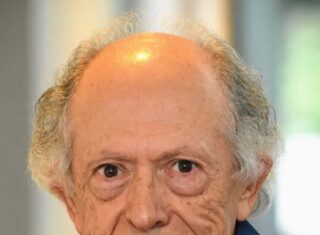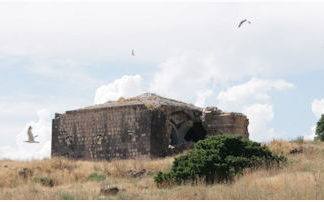On Sunday, an audience at the Armenian Library and Museum of America (ALMA) saw another side of the embattled doctor responsible for the deaths of an estimated 130 people who sought his services: the artist.
Now on parole after serving eight years of a 25-year sentence for murder, a noless- strident Kevorkian appeared at the October 5 opening of an exhibition of his artwork, titled “The Doctor Is Out.”
Art has been an outlet for Kevorkian since the 1960s, when he was working as a pathologist in Michigan. One of the works from this period includes blood he drew while working at a lab — and barbed wire.
“That was harder to get,” Kevorkian said as he led a crowd of 300 on a tour of the 16 pieces on display.
Utilizing mostly oil on canvas, Kevorkian’s art is visually and thematically jarring. Three paintings, “Coma,” “Paralysis” and “Fever,” show a human form afflicted by the corresponding titles. “Nearer My God to Thee” reveals a man grasping for two walls as he slides into an abyss crowded by ghost-like faces.
Other works strike more political chords. “1915 Genocide 1945,” a three-dimensional mixed-media piece, is the only work that refers overtly to Kevorkian’s Armenian heritage. His parents were Genocide survivors who settled in Michigan. The most conventional canvasses on display include portraits of his mother, father and Johan Sebastian Bach, to whom he referred as his personal God in 1996.
“It really isn’t art,” Kevorkian said of his oeuvre. “Its main mission is conveying a philosophic point, an abstract point. I call it pictorial philosophy.”
Kevorkian said his painting was curtailed following his conviction for second-degree murder in 1999. He had been tried unsuccessfully in Michigan four times on similar charges, escaping on a loophole that allowed those assisting suicide to remain inculpable.
A 1998 law repealing the loophole would later be used to convict Kevorkian — a verdict he told the audience was welcomed in order to draw attention to the cause of assisted suicide.
Kevorkian credited his attorney, Mayer Morganroth, for saving his art from an uncertain fate following his imprisonment. Morganroth received a standing ovation from the audience.
Questioners were met with a plea not to ask about his position on assisted suicide, which Kevorkian said he is forbidden to talk about under the terms of his parole. After four denied parole requests, he was released in June 2007 following a terminal Hepatitis-C diagnosis. He is 80-years-old.
“It scares me because it may curtail my life,” Kevorkian said of his illness. “I was afraid I might die in prison. Dying in prison is a vacuous death — meaningless. Being in prison is meaningless. I tried to make it meaningful. I wrote a book, I got some ideas, I got a new mission in life.”
Film producer Steve Jones has been following Kevorkian since his release last year, filming the exhibition opening for a documentary that will be released in 2009. He is working with HBO to produce a scripted film titled “You Don’t Know Jack.”
Asked about Kevorkian’s favorable reception at the museum, Jones said other audiences have been less enthusiastic. He said a lecture at the University of Florida required bomb-sniffing dogs after Kevorkian received death threats.
“They like one of their own,” Jones said of the museum’s audience. “He may be the most famous Armenian of the last several decades.”
While in prison, Kevorkian decided to run for Michigan’s ninth district seat in Congress, which Jones is also documenting. Kevorkian is running against incumbent Joe Knollenberg, a popular Republican who has taken positions favorable to the district’s sizable Armenian population.
Citing his poor health and distaste for career politicians, Kevorkian said he is only running for one term. “That’s all you need,” he said. “If you can’t do everything in one term, it’s hopeless. Stay there longer and the corruption rubs off on you.
“Who knows? I may be dead in two years.” Asked about his opinion of the Congressional resolution to recognize the Armenian Genocide, Kevorkian said he was unimpressed with such efforts.
“The United States does not recognize the Armenian Genocide,” he said. “You can pass any resolution you want; it won’t work. You’ve got to understand that. Don’t put your faith in public recognition of what happened to us.”
Audience member Shant Broukian said he wasn’t surprised by Kevorkian’s dismissal of the issue given the cynicism in his art.
“It’s the same as the paintings; he’s looking at the negative as everyone looks at the positives,” Broukian said. “That’s how it’s turning out to be — the negatives.”
ALMA director Mariam Stepanayan said Kevorkian’s collection has been in the museum’s possession since 1999. This is the first exhibition since a 1999 show in California — which Kevorkian could not attend.
“Having him here is really amazing, because we can get from the artist himself his view of his art,” Stepanayan said. “Now, Dr. Kevorkian’s collection has a home. They won’t be orphaned, and there’s an Armenian home to take care of his art.”
“I didn’t like the idea of selling (the paintings) individually, and I didn’t know what was
going to happen to them when I die,” Kevorkian said of the collection. “So this turned out to be a good solution.”
“The Doctor Is Out” will run through December 5.








